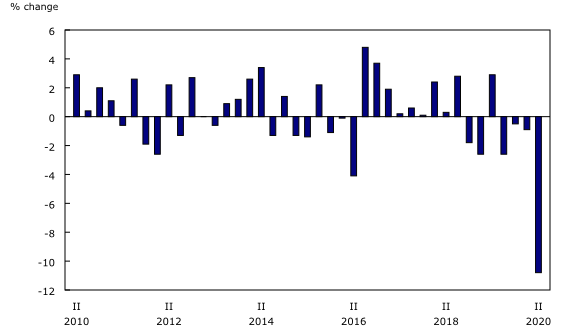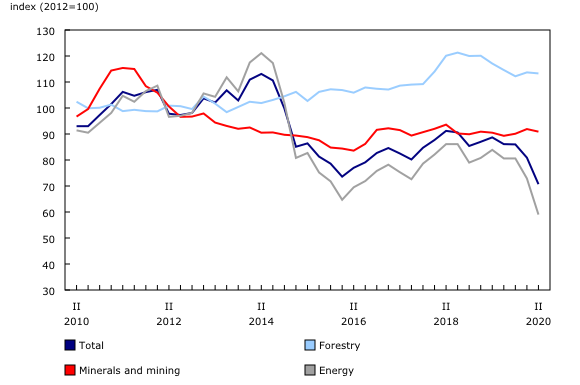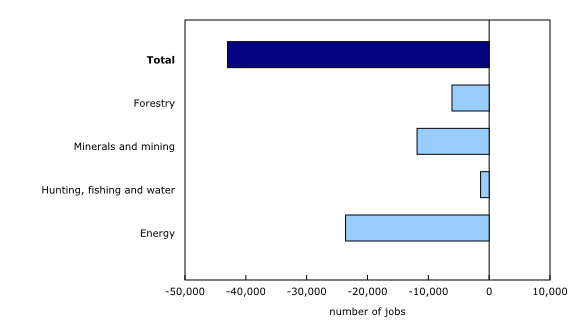Natural resource indicators, second quarter 2020
Archived Content
Information identified as archived is provided for reference, research or recordkeeping purposes. It is not subject to the Government of Canada Web Standards and has not been altered or updated since it was archived. Please "contact us" to request a format other than those available.
Released: 2020-09-23
Record decline in natural resources real gross domestic product
Real gross domestic product (GDP) of the natural resources sector fell 10.8% in the second quarter, the fourth consecutive quarterly decline. The second-quarter decrease—the steepest since quarterly data were first recorded in 2007—reflected a substantial drop in demand for natural resources owing to the slump in economic activity in Canada and in its major trading partners with the onset of the COVID-19 pandemic.
Economy-wide real GDP fell 11.5% in Canada; declines were 9.1% in the United States and 20.4% in the United Kingdom.
The second quarter contraction in natural resources real GDP was broad-based. A 10.1% decline in the energy subsector was mainly attributable to a substantial drop in demand for crude oil and refined petroleum products. Demand fell largely because of global travel restrictions and the growing prevalence of working and schooling at home.
Real GDP of the minerals and mining subsector declined 14.2%; a 16.0% drop in metallic minerals was partly offset by a 5.6% rise in non-metallic minerals, led by increased extraction of potash.
Real GDP of the forestry subsector fell 10.1%, the steepest drop ever recorded, reflecting a sharp decline in housing investment (-14.9%) and weak international demand.
Hunting, fishing and water fell 7.0% in the second quarter.
Impacts of COVID-19
In the second quarter of 2020, the natural resources sector contracted sharply owing to the COVID-19 pandemic. The decline was exacerbated by lower international demand for natural resources, as the economic activity of major trading partners (such as the United States, the United Kingdom and Japan) fell sharply.
As government measures to contain the pandemic in Canada and elsewhere have been relaxed, production, prices, exports, and employment in natural resources have been rising; the extent of gains will be reflected in the next release.
Export and import volumes fall
Natural resource export volumes fell 9.6% in the second quarter, with energy (-11.1%), minerals and mining (-8.3%) and forestry (-3.4%) down on weak international demand.
The decline in import volumes (-10.8%) was substantial; a 31.8% drop in energy and a 8.2% decline in forestry imports were partly offset by a 16.5% rise in minerals and mining.
Canada has long been a net exporter of natural resources—export values are generally about double those of imports.
Sharp decline in natural resource prices and nominal GDP
Overall, natural resources prices fell 12.6%, led by a 37.2% drop in the price of crude oil and a 29.2% decline in the price of refined petroleum products that reflected weakened demand for air and road transportation and a higher global energy supply.
Both price and volume declines contributed to the sharp drop in nominal GDP of the natural resources sector. Expressed as an annual rate, the nominal GDP of natural resources was $157.7 billion in the second quarter, representing 8.4% of the Canadian economy, down from 9.5% in the first quarter.
The energy subsector's share of the natural resources GDP was 60.3% in the second quarter, followed by minerals and mining at 23.9% and forestry at 9.1%. Hunting, fishing and water accounted for the remaining 6.7%.
Employment falls
Employment in the natural resources sector fell 7.3%, the steepest decline ever recorded. Shutdowns of non-essential businesses and very low resource prices contributed to broad-based job losses: energy (-23,600 jobs), minerals and mining (-11,850), forestry (-6,100) and hunting, fishing, and water (-1,400). Declines were mitigated by the Canada Emergency Wage Subsidy, which provided incentives to employers to retain employees in the payroll.
Slump in downstream activities
For analytical purposes, secondary and tertiary processing for the forestry and the minerals and mining subsectors are identified separately. Real GDP of these downstream activities fell sharply (-24.0%) as primary and secondary activities were severely restricted.
Note to readers
Data on natural resources for the second quarter have been released along with revised data from the first quarter of 2020.
The natural resource indicators provide quarterly indicators for the main aggregates in the Natural Resource Satellite Account (NRSA), namely, gross domestic product, output, exports, imports, and employment. The estimates from this account are directly comparable to the estimates in the Canadian System of Macroeconomic Accounts.
Core natural resources: The NRSA defines natural resource activities as those which result in goods and services originating from naturally-occurring assets used in economic activity, as well as their initial processing (primary manufacturing).
Downstream activities: Although not part of the core account, natural resources have important downstream effects on other sectors. In general, this production uses a large portion of primary manufactured products as inputs.
Next release
Data on natural resource indicators for the third quarter of 2020 will be released on January 15, 2021.
Products
The Economic accounts statistics portal, accessible from the Subjects module of our website, features an up-to-date portrait of national and provincial economies and their structure.
Additional information can be found in the articles "The Natural Resources Satellite Account: Feasibility study" and "The Natural Resources Satellite Account – Sources and methods," which are part of the Income and Expenditure Accounts Technical Series (13-604-M).
The Latest Developments in the Canadian Economic Accounts (13-605-X) is available.
The User Guide: Canadian System of Macroeconomic Accounts (13-606-G) is available.
The Methodological Guide: Canadian System of Macroeconomic Accounts (13-607-X) is available.
Contact information
For more information, or to enquire about the concepts, methods or data quality of this release, contact us (toll-free 1-800-263-1136; 514-283-8300; STATCAN.infostats-infostats.STATCAN@canada.ca) or Media Relations (613-951-4636; STATCAN.mediahotline-ligneinfomedias.STATCAN@canada.ca).
- Date modified:





